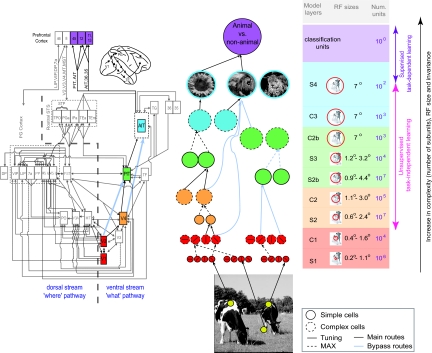Fig. 1.
Sketch of the model. Tentative mapping between the ventral stream in the primate visual system (Left) and the functional primitives of the feedforward model (Right). The model accounts for a set of basic facts about the cortical mechanisms of recognition that have been established over the last decades: From V1 to IT, there is an increase in invariance to position and scale (1, 2, 4–6), and in parallel, an increase in the size of the receptive fields (2, 4) as well as in the complexity of the optimal stimuli for the neurons (2, 3, 7). Finally, adult plasticity and learning are probably present at all stages and certainly at the level of IT (6) and PFC. The theory assumes that one of the main functions of the ventral stream, just a part of the visual cortex, is to achieve a tradeoff between selectivity and invariance within a hierarchical architecture. As in ref. 5, stages of simple (S) units with Gaussian tuning (plain circles and arrows) are loosely interleaved with layers of complex (C) units (dotted circles and arrows), which perform a max operation on their inputs and provide invariance to position and scale (pooling over scales is not shown). The tuning of the S2, S2b, and S3 units (corresponding to V2, V4, and the posterior inferotemporal cortex) is determined here by a prior developmental-like unsupervised learning stage (see SI Text). Learning of the tuning of the S4 units and of the synaptic weights from S4 to the top classification units is the only task-dependent, supervised-learning stage. The main route to IT is denoted with black arrows, and the bypass route (38) is denoted with blue arrows (see SI Text). The total number of units in the model simulated in this study is on the order of 10 million. Colors indicate the correspondence between model layers and cortical areas. The table (Right) provides a summary of the main properties of the units at the different levels of the model. Note that the model is a simplification and only accounts for the ventral stream of the visual cortex. Of course, other cortical areas (e.g., in the dorsal stream) as well as noncortical structures (e.g., basal ganglia) are likely to play a role in the process of object recognition. The diagram (Left) is modified from ref. 58 (with permission from the author) which represents a juxtaposition of the diagrams of refs. 46 and 59.

